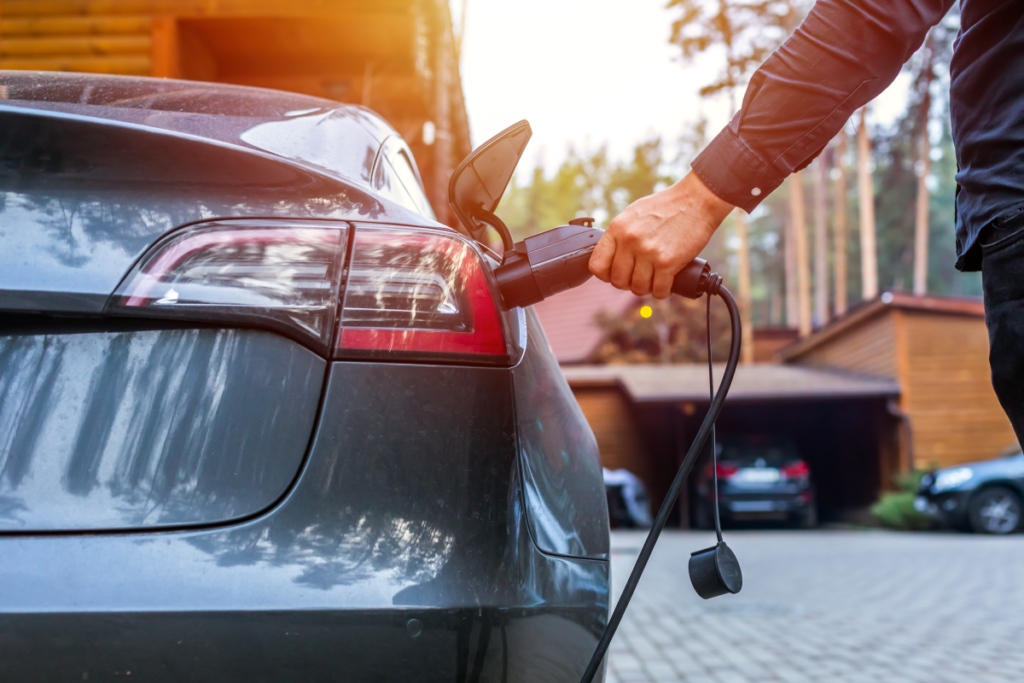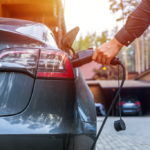-
 play_arrow
play_arrow
Radio Rehoboth


Delaware has opted to reduce gas car sales to 82% by 2032, with hopes of reassessing the program after that date. | PHOTO COURTESY OF ADOBE STOCK
DOVER — Delaware has formally set the required emission standards for cars over the next decade, severely limiting the number of gasoline-powered vehicles but not as much as originally proposed.
The regulation that will take effect Dec. 11 commits the First State to require 43% of new cars and trucks sold in Delaware to be electric or hybrid models, starting with car model year 2027. That percentage will increase to 82% in 2032, and the following year the rule will expire.
Delaware Department of Natural Resources and Control (DNREC) Secretary Shawn Garvin wrote in his order yesterday that he found the public concerns about cost and charging infrastructure access sufficient to adopt a plan altered from the one proposed by Gov. John Carney. It would still give time for the state’s infrastructure and market to catch up with where many states are heading.
“If Delaware adopts only through 2032, [there is evidence] that significant reductions in nitrogen oxides, particulate matter, and carbon dioxide will be achieved,” Garvin wrote. “This approach not only helps achieve significant pollution reduction from vehicle emissions, but this will ensure that Delaware makes the changes necessary to support the transition to [zero emission vehicles], while avoiding the requirement that they become 100% of the new vehicle sales market.”
The new rule is a compromise between the standard first set by California that prohibits the sale of gas-powered cars entirely by 2035 and those set by the U.S. Environmental Protection Agency. In April, the EPA proposed regulations that would mean companies would have to manufacture 67% electric or hybrid vehicles by 2032.
In 2022, Carney announced his administration’s intent to prohibit sales of gas-powered cars entirely by the 2034 model year. Sixteen other states announced it would follow the California standard, including Delaware’s neighbor Maryland. Earlier this month, New Jersey had recently announced it would join the movement.
By limiting the cap to 82% and ending a few years shy of the 2035 deadline – allowing a potential reassessment of the market at that time – the First State would join Maine, Colorado and New Mexico in targeting 82% adoption.
Carney had been bullish on enacting meaningful environmental legislation in one of his last years in office, succeeding in signing the Climate Change Solutions Act this year. That law outlines the ambitious goal of reaching net-zero carbon emissions in Delaware by 2050.
“Over the next decade, Delaware will transition to a clean energy future to reduce pollution and take on climate change,” the governor told the Delaware Business Times. “Addressing transportation emissions is a critical part of that effort. This revised regulation – similar to regulations in New Mexico, Colorado, and Maine – is a thoughtful approach that will not eliminate gas-powered vehicles, but continue to move us forward.”
DNREC estimates that cars produce 30% of the state’s total emissions, and of that amount, more than half are generated from driver-owned cars and trucks. According to the state’s current projections, transportation is predicted to generate 4.8 million metric tons of emissions by 2050.
In Delaware, electric vehicle adoption rates are slow, making up less than 1% of all registered cars in the state. As of the end of July, there were 6,657 EVs out of the roughly 1 million cars registered with the Delaware Division of Motor Vehicles. The average cost of an electric vehicle in summer 2023 was $53,469, according to the Kelley Blue Book.
The Delaware Auto and Truck Dealer Association, which represents 54 vehicle dealerships across the state, issued a statement that it was disappointed in the DNREC order, noting that there are “real world issues that prevent a full adoption at the pace” outlined.
“We have concerns about the affordability of vehicles going forward in the state, and what this will mean for our ability to stock affordable vehicles in a few years,” DATDA President Chip Sheridan told the Delaware Business Times. “We have yet to see any data or plan that shows how the required sales are even feasible. Like everyone, we believe in reducing emissions in the state. That being said, these targets are unmanageable and will directly lead to a lack of affordable vehicles for customers in Delaware.”
Delaware’s adoption of the California standard has already made an impact, as Jeep, Chrysler and Dodge parent company Stellantis has said that it will no longer stock some gas-powered models here as it looks to manage inventory levels between states and a move to expand EV production.
Even if there is a significant push to buy electric, Delaware also has to ramp up its charging infrastructure. DNREC officials estimated there are 450 public charging ports in the state with many along Interstate 95. Federal funding has been approved through the Bipartisan Infrastructure Law and the Inflation Reduction Act to pay for more along Delaware’s highways.
The state has also rolled out a series of new laws to help boost electric vehicle adoption. Carney amended the state rebate program to apply to used EVs and he also signed a new law to require homebuilders to plan for charging infrastructure. Retrofitting a home to install an EV charger could cost as low as $750 to thousands of dollars, while relocating the electric panel at home could cost $200.
The California standard — or prohibiting the sale of gas-powered cars entirely by 2035 — still sets its benchmark of 82% at 2032. But under the DNREC order, there is no legal requirement to push customers and auto dealers to sell hybrid or electric cars after that date.
DNREC will evaluate the program’s progress and whether to extend the regulation in future years, a DNREC spokesperson told the Delaware Business Times. In the meantime, the department will track its progress while advancements in technology, supply chains and battery cost/performance are presumably occurring in the automotive industry.
If state officials opt to discontinue the zero-emission plan after 2032, Delaware would still have to follow the federal standard, which as of now would be at least 60% in 2032. Either way, DNREC believes that more electric cars will be needed in the state, and the current regulations will move the needle.
“By adopting the revised regulation, DNREC aims to protect public health, reduce emissions, and align with Delaware’s climate goals – all while providing consumers with cleaner and more sustainable transportation options,” Garvin wrote in a statement. “This decision will result in cleaner air in Delaware and strengthen protections for communities overburdened by exposure to tailpipe pollution.”
Go to Source:https://delawarebusinesstimes.com/news/reduce-gas-car-sales-2032/
Author: Katie Tabeling
Written by: RSS
Similar posts
-

This Way Out
LGBTQ community radio program
TWO is a volunteer-produced, multi-award-winning, internationally-syndicated weekly half-hour “magazine style” LGBTQ community radio program based in Los Angeles, currently heard on more than 200 local community radio stations across North America, in the Netherlands, the U.K., Australia, South Africa, India, and New Zealand; on satellite to home and cable outlets across Europe, the Middle East/Africa and Asia/Pacific regions via the London-based World Radio Networks. TWO is produced and distributed by Overnight Productions, Inc., a 501(c)3 non-profit corporation. Mission: To educate, inform and entertain audiences around the world by making freely available the presentation of news, features and cultural works by and about the international lesbian, gay, bisexual and transgender community via audio broadcast and cyber media.
close Chart
Top popular

News Briefs 10/17/23
Board of Commissioners Workshop & Special Meeting – November 6

Six Sussex road projects considered in latest CTP
Knicks vs. Cavaliers prediction, odds, line, spread, time: 2023 NBA picks, Nov. 1 best bets from proven model
NFL Week 17 highlights: Packers, 49ers, Saints, Steelers win, Cardinals stun Eagles
Copyright 2023 East Sussex Public Broadcasting, Inc.





